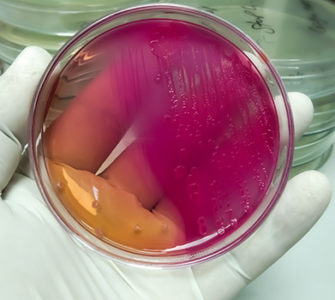‘Old bug’ with new name easily mistaken for E. coli peritonitis
Commercial chicken flocks that appear to have Escherichia coli peritonitis might actually be infected with a re-emerging old pathogen with a new name.
“Gallibacterium anatis is an old bug that used to be called Pasteurella haemolytica or avian Mannheimia haemolytica but was recently established as a new genus within the family of Pasteurellaceae,”1 explains Kalen Cookson, DVM, MAM, Dpl. ACPV, of Zoetis.
Historically, G. anatis presented like fowl cholera. Today, it’s considered a respiratory pathogen, but some strains become systemic and have an affinity for the reproductive tract, Cookson says. The result can be peritonitis, airsacculitis, salpingitis, follicle degeneration, decreased egg production and mortality, he adds.
“It can look a lot like E. coli peritonitis and, in flocks vaccinated against E. coli, can lead to the erroneous assumption that an E. coli vaccine failure has occurred,” Cookson says.
Lab results
G. anatis can be readily isolated when in pure culture, and isolates are often multi-drug resistant. Some labs, however, aren’t equipped to identify this pathogen and may misreport it as Pasteurella sp. or M. haemolytica, Cookson continues.
In addition, co-infection with G. anatis and E. coli is possible, particularly in flocks that have not been vaccinated against E. coli. In such cases, E. coli can outgrow and mask G. anatis upon testing, and a proper diagnosis of G. anatis may be missed, he says.
“There are a lot of unknowns about G. anatis. There’s a theory that reovirus infection in layers may cause immune suppression that makes birds more susceptible to G. anatis and E. coli, but we don’t know for sure,” Cookson says.
Different strains
Donna Kelly, DVM, MASCP, DACPV, head of microbiology at the University of Pennsylvania School of Veterinary Medicine, says two clonal lineages of G. anatis have been determined based on DNA fingerprinting.2 One type has an affinity for the upper respiratory tract and the other for the lower reproductive tract, suggesting niche adaptation.
There are different strains of G. anatis with different levels of virulence and some are more pathogenic than others, she explains, but G. anatis is primarily opportunistic and can also be found in the avian upper respiratory tract without causing clinical signs or lesions.
“It appears that predisposing factors such as host immunosuppression, concurrent infectious bronchitis virus (IBV) or mycoplasma infection allow the normal flora populations of G. anatis to express their virulence,” she says.
In layers, peak egg production is another predisposing factor for G. anatis, she explains. It can cause immunosuppression that allows opportunistic organisms to gain a foothold in the chicken’s body; as time goes by, the bacterial load increases until the host cannot maintain control and infection develops. Peak production also brings changes in hormone levels and pH changes that can give bacteria an advantage as their environmental parameters change.
G. anatis can be passed bird-to-bird, although a low rate of vertical transmission is suspected. Infection in male breeders has a negative effect on fertility due to the production of abnormal sperm and poor-quality semen,3 Kelly says.
“The majority of the cases I have seen have been in layer chickens and backyard chickens. Sporadic broiler cases have also been encountered,” she says.
No breed predisposition
In layers, there appears to be no breed predisposition to the disease. All adults are susceptible; however, there is clustering in layers 40 to 50 weeks of age. These cases usually present with elevated mortality, more often than eggshell issues, although there have been sporadic cases with both, Kelly reports.
Upon necropsy, peritonitis is a common finding. As the disease progresses, or if there are complicating factors, it is possible to have full-blown polyserositis (pericarditis/perihepatitis/airsacculitis complex) accompanied by caseous salpingitis. Enlarged livers and spleens are also common. The majority of the cases are co-infections with E. coli and, more recently, with Ornithobacterium rhinotracheale, she says.
Many layer and backyard flocks have concurrent IBV or mycoplasma infections, or they have serologic evidence of IBV challenge.
The broiler cases seen have been in birds 25 days of age and older, Kelly adds. Affected flocks have elevated mortality — about 0.3% mortality — and respiratory noise. As in layers, necropsy lesions are typical of polyserositis. On occasion, there is a flock affected by G. anatis that has been labeled as a “poor doer” from placement, with chronic elevated mortality. IBV is also common in these cases, she says.
1. Jones KH, et al. A 5-year retrospective report of Gallibacterium anatis and Pasteurella multocida isolates from chickens in Mississippi. Poult Sci. 2013;92:3166-3171.
2. Bojesen AM, et al. Genetic Diversity of Gallibacterium anatis isolates from different chicken flocks. J Clin Microbiol. 2003 June;41(6);2737-2740.
3. Persson G, et al. Bacterial determinants of importance in the virulence of Gallibacterium anastis in poultry. Vet Res. 2015;46:57.
Posted on April 12, 2017

















